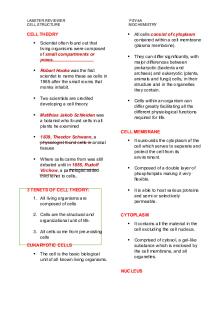Protein Denaturation in Labster PDF

| Title | Protein Denaturation in Labster |
|---|---|
| Author | saint liunidas |
| Course | BS Medical Technology |
| Institution | University of the East Ramon Magsaysay |
| Pages | 7 |
| File Size | 275.8 KB |
| File Type | |
| Total Downloads | 47 |
| Total Views | 158 |
Summary
Protein Denaturation in Labster Simulation (Notes)...
Description
PROTEIN DENATURATION is the irreversible process in which the native structure of a protein is disrupted. • Loss of 3D shape • Loss of biological function • Changes the characteristics of food. STAGES OF DENATURATION UNFOLDING Hydrogen and other bonds stabilizing the structure are broken, which means that the amino acid side chains are more exposed to the solvent. New bonds are formed as different amino acids form new interactions with each other.
During Protein Denaturation Close amino acids in the backbone start to interact, forming ionic bonds (called salt bridges). The formation of these new bonds leads to the creation of secondary structures called alpha helices and beta sheets.
Primary and Secondary Protein Structures
Ovalbumin – the main protein in found in the egg white, that makes up 60-65% of the total protein. Function=unknown * presumed to be a storage protein.
Tertiary Structure
Quarternary Structure
• When interactions between distant amino acids occur, proteins get their 3D structure, where new interactions take place: new ionic bonds, new Hydrogen bonds, disulphur bonds, and hydrophobic interactions.
Alpha helices are formed in the secondary structure. In order to create an alpha helix, hydrogen bonds formed between amino acids must be separated by a distance of 4 amino acids. These interactions will make the to turn and form the helix.
• Quarternary structure is built by 4 subunits distinguished through different colors.
• The specific 3D protein structure determines the protein solubility.
• Hydrophilic amino acid residues → surface interacting with water • Hydrophilic amino acid residues have a net charge that allows the protein to dissolve in water. • Hydrophobic resides → exposed to the solvent due to any disturbance, a decrease in protein solubility occurs, which eventually could lead to protein precipitation.
Distilled water does not have proteins, that’s why it’s fit to be used as a negative control.
OVALBUMIN + substance
Acetic Acid - Salt bridges contributing to the tertiary and quarternary structures are disrupted. - The atoms that were involved in keeping that configuration starts to interact with the newly introduced positive charges.
Acetic acid = weak acid Therefore, it partially disassociates in solution. If you use a strong acid, such as hydrochloric acid, the secondary structure will also be disrupted. - Lumps are formed
Acetic acid + ovalbumin = denaturation and coagulation
CASEIN – lumpy texture, protein found in milk whenever milk is not well preserved.
Sodium Hydroxide - Induces ovalbumin denaturation because it’s a base, which modifies the pH of the ovalbumin solution. - Since it’s a strong base, the salt bridges are disrupted. - Appearance of new interactions between secondary structure are visible as lumps.
Strong base = secondary, tertiary, and quarternary levels Weak base = only tertiary and quarternary structures are affected This is due to the partial dissociation of the weak base in solution.
Ethanol - Addition of alcohol disrupts the Hydrogen bonds present in the quarternary, tertiary, and secondary structure - forming new interactions between the alcohol and the amino acids. - Visible lumps
WHY IS A 70% SOLUTION USED AS A DISINFECTANT? This concentration is able to penetrate bacteria cell wall and denature the proteins and enzymes inside of the cell....
Similar Free PDFs

Protein Denaturation in Labster
- 7 Pages

Week2 labster
- 4 Pages

PROTEIN
- 21 Pages

Week 4 Labster Activity
- 4 Pages

Crispr - Paper( Labster)
- 3 Pages

Labster Report Organic Chemistry
- 23 Pages

Bio week 1 labster
- 4 Pages

Labster 1 cell structure
- 10 Pages

Summary for Labster
- 5 Pages

Week 3 labster
- 3 Pages

Microbiology labster microscopy
- 4 Pages

Week 6 labster
- 4 Pages

Labster Module PCR
- 5 Pages
Popular Institutions
- Tinajero National High School - Annex
- Politeknik Caltex Riau
- Yokohama City University
- SGT University
- University of Al-Qadisiyah
- Divine Word College of Vigan
- Techniek College Rotterdam
- Universidade de Santiago
- Universiti Teknologi MARA Cawangan Johor Kampus Pasir Gudang
- Poltekkes Kemenkes Yogyakarta
- Baguio City National High School
- Colegio san marcos
- preparatoria uno
- Centro de Bachillerato Tecnológico Industrial y de Servicios No. 107
- Dalian Maritime University
- Quang Trung Secondary School
- Colegio Tecnológico en Informática
- Corporación Regional de Educación Superior
- Grupo CEDVA
- Dar Al Uloom University
- Centro de Estudios Preuniversitarios de la Universidad Nacional de Ingeniería
- 上智大学
- Aakash International School, Nuna Majara
- San Felipe Neri Catholic School
- Kang Chiao International School - New Taipei City
- Misamis Occidental National High School
- Institución Educativa Escuela Normal Juan Ladrilleros
- Kolehiyo ng Pantukan
- Batanes State College
- Instituto Continental
- Sekolah Menengah Kejuruan Kesehatan Kaltara (Tarakan)
- Colegio de La Inmaculada Concepcion - Cebu


